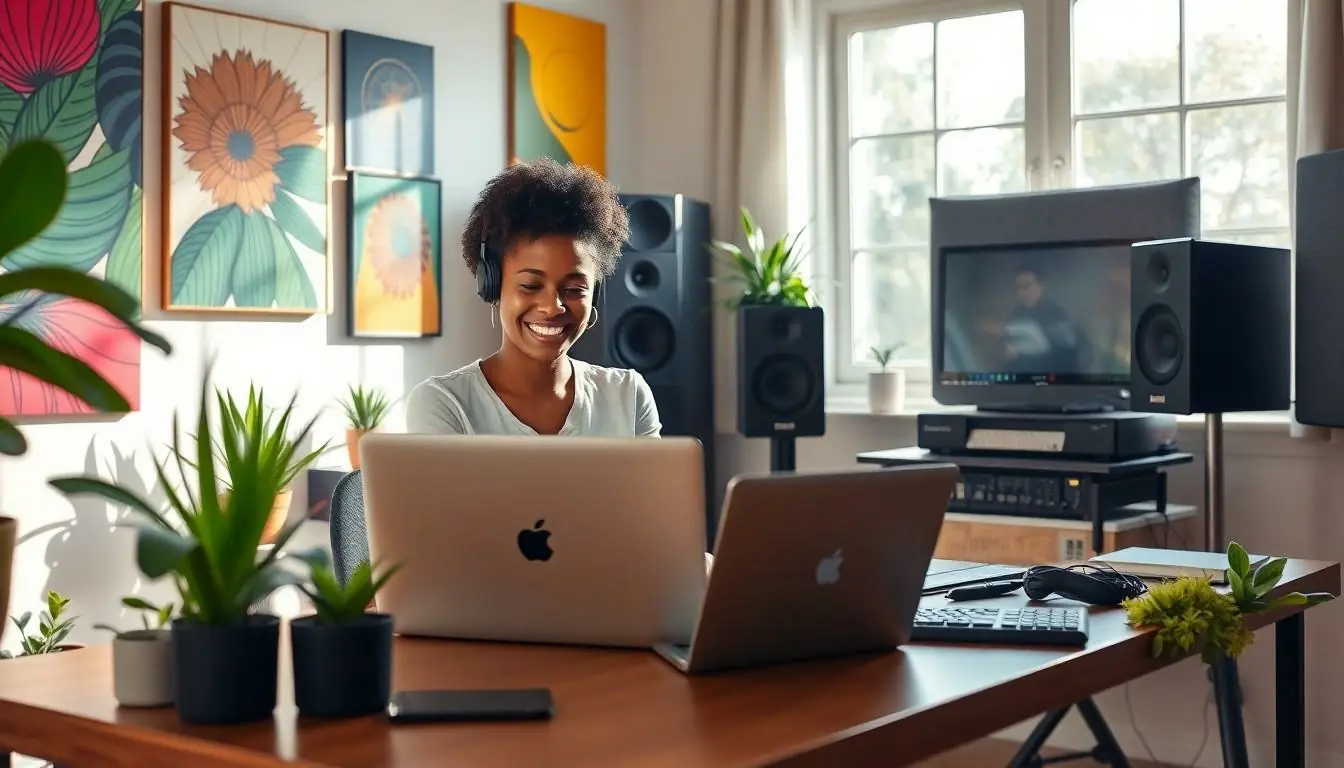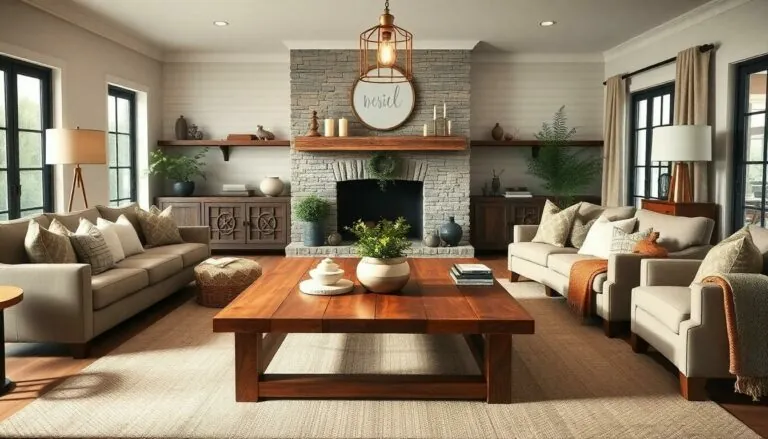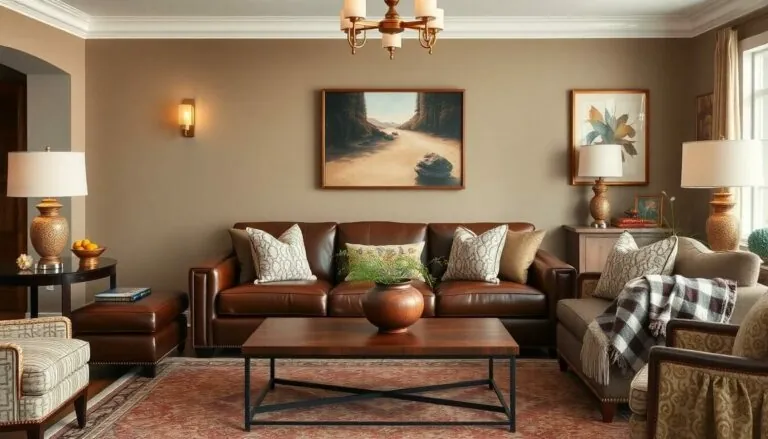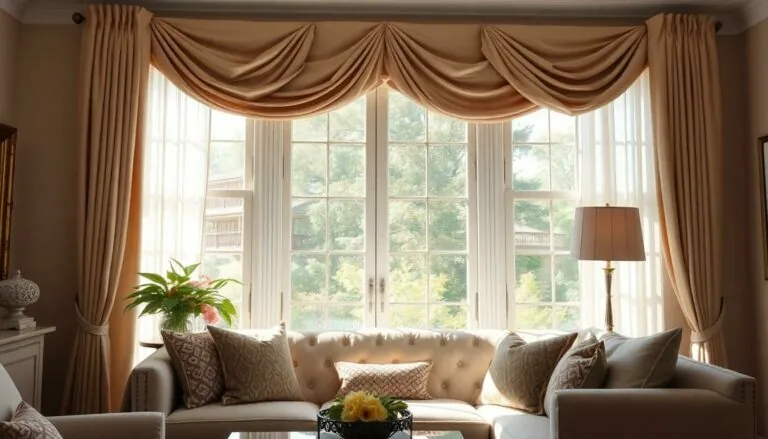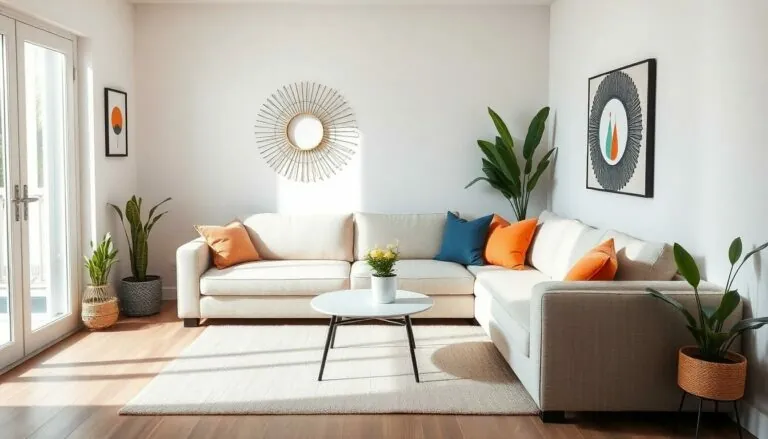Table of Contents
ToggleCreating a home studio is like building your personal playground for creativity. Whether it’s music, art, or podcasting, the right environment can spark inspiration and keep those creative juices flowing. Imagine a space where every corner whispers ideas and every wall encourages your wildest dreams. Sounds nice, right?
Home Studio Inspiration: Creating Your Perfect Space
Designing a home studio involves careful consideration of layout and functionality. Incorporating creative elements enhances the overall vibe. Colors play a significant role; vibrant hues can energize while softer tones promote calmness.
Furniture selection impacts comfort levels and productivity. Ergonomic chairs support long hours of work. Desks should offer ample space for equipment and supplies, ensuring everything is easily accessible.
Lighting contributes to the overall atmosphere and mood. Natural light should be maximized, as it boosts creativity and energy. When natural sources aren’t available, consider using adjustable LED lights for flexibility.
Organization systems keep the workspace clutter-free. Shelving units, drawers, and storage boxes help maintain order. Each item should have a designated space, simplifying workflows and reducing distractions.
Tech equipment forms the backbone of any home studio. Invest in high-quality audio interfaces, microphones, or cameras tailored to individual needs. Research products for reliability and compatibility with existing systems.
Decorative touches personalize the studio. Artwork, plants, or inspirational quotes can spark creativity. Selecting pieces that resonate personally adds a unique flair, transcending traditional aesthetics.
Soundproofing materials improve audio quality and minimize distractions. Acoustic panels or heavy curtains absorb sound, creating a more controlled environment. Budget-friendly options can still provide significant benefits.
Creativity flourishes in a well-thought-out home studio. Prioritizing comfort, organization, and inspiration leads to an engaging workspace for music, art, or podcasting endeavors.
Choosing the Right Location
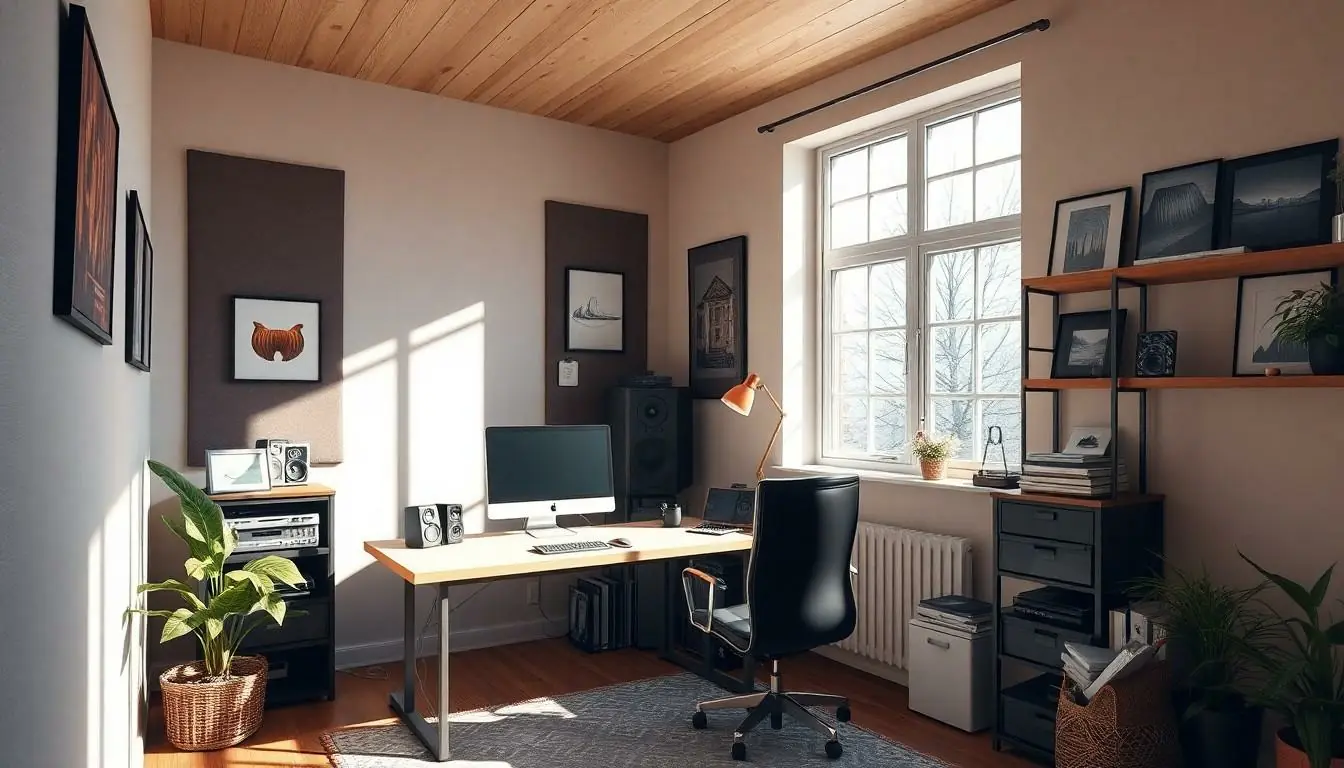
Selecting the ideal location for a home studio plays a crucial role in fostering creativity and enhancing productivity. Factors like space, lighting, and noise levels influence the overall effectiveness of the studio environment.
Assessing Your Space
Evaluating available space helps determine the studio’s layout and functionality. A small room can serve a dedicated purpose, while a larger area offers flexibility. Consider natural light sources as they greatly affect mood and creativity. Identify areas for equipment and workstations to maximize efficiency and ensure comfort. Assessing layout possibilities fosters a seamless workflow, allowing easy access to all necessary tools and materials.
Noise Considerations
Addressing noise levels is critical for both audio quality and focus. Select a location away from street noise or distractions. Evaluate soundproofing options such as acoustic panels or heavy curtains to manage external sounds effectively. Utilizing thick carpets can absorb noise and enhance comfort. Ensuring a quiet atmosphere supports concentration and promotes creativity, essential for a productive workspace. Prioritizing a peaceful environment enhances the overall home studio experience.
Essential Equipment for Your Home Studio
A well-equipped home studio makes creativity flow seamlessly. The right gear and acoustic treatment lay the foundation for high-quality output.
Recording Gear
Microphones capture sound, becoming the centerpiece of any recording setup. Options range from condenser to dynamic microphones, each serving specific purposes. An audio interface connects instruments and microphones to the computer, ensuring high-quality sound conversion. Headphones play a key role in monitoring sessions, helping artists detect issues in real-time. Studio monitors provide accurate playback, revealing details that headphones might miss. Cables, adapters, and stands complete the setup, ensuring everything functions smoothly. Investing in reliable recording gear enhances the audio production experience.
Acoustic Treatment
Acoustic treatment minimizes unwanted sound reflections, enhancing recording clarity. Foam panels absorb sound, reducing echoes and improving the overall sound quality. Bass traps target low frequencies, preventing muddiness in recordings. Carpets and curtains act as supplementary treatments, softening sound reflections. Monitoring speaker placement ensures optimal acoustics within the room. Strategic arrangements create a balanced sound environment, encouraging precise mixing and mastering. Attention to acoustic treatment elevates the professionalism of home studio recordings.
Design Ideas for a Motivating Environment
Creating a motivating environment involves thoughtful design choices that enhance creativity. Color schemes and furniture arrangement significantly influence the workspace atmosphere.
Color Schemes and Themes
Vibrant colors can energize a space, while calming tones promote focus. Consider using shades like blue or green for tranquility, integrating them with accent colors to stimulate creativity. Neutrals create a versatile backdrop, allowing personal touches to shine through. Specific themes can establish an inviting vibe; for instance, a minimalist approach fosters clarity, while eclectic styles add character. Soothing pastels can balance bold hues, creating a visually appealing contrast.
Furniture Arrangement
Ergonomically designed furniture supports comfort and productivity. Position desks to face windows, maximizing natural light for an inspiring work environment. Allow adequate spacing between items to facilitate movement and reduce clutter. Shelving should be easily accessible, keeping essential tools within reach. Arranging seating areas can foster collaboration if the studio is shared. Utilize standing desks or adjustable seating options to enhance flexibility, accommodating various tasks.
Personalizing Your Home Studio
Personalizing a home studio involves adding unique touches that reflect individual creativity. It enhances the atmosphere, making it a more inspiring space.
Displaying Art and Inspiration
Incorporating inspiring artwork can elevate the studio’s vibe. Hanging pieces that resonate with personal experiences motivates creativity. Selecting a mix of different styles—from abstract paintings to photography—adds visual interest. Those pieces should be displayed at eye level for immediate impact. Rotating artwork regularly can keep the environment fresh and stimulating. Creating a gallery wall with eclectic works fosters a dynamic creative space. Additionally, personal achievements, such as framed awards or certificates, contribute to a sense of accomplishment.
Incorporating Natural Elements
Integrating natural elements brings a calming influence to the workspace. Incorporating indoor plants like succulents or snake plants not only improves air quality but also adds a touch of greenery. Choosing natural materials for furniture, such as wood or stone, creates a warm atmosphere. Natural light plays a crucial role, so arranging the workspace near windows maximizes brightness. Utilizing organic textures in decor, like woven baskets or linen cushions, enhances comfort. Emphasizing these elements fosters a more inviting and serene creative environment.
Creating a home studio is about more than just equipment; it’s about crafting an inspiring environment that nurtures creativity. By thoughtfully considering layout, color schemes, and personal touches, individuals can design a space that resonates with their artistic vision.
Incorporating elements like ergonomic furniture and effective lighting enhances comfort and productivity. Additionally, soundproofing and organization play crucial roles in minimizing distractions and streamlining workflows.
Ultimately, a well-designed home studio reflects personal style while fostering an atmosphere where creativity can thrive. With the right balance of inspiration and functionality, anyone can transform their space into a hub of artistic expression.


